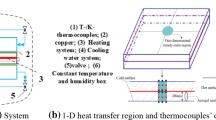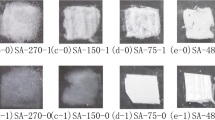Abstract
Silica aerogel is a nano-porous ultra-light weight aggregate, and its excellent thermal insulation performance has attracted much attention in building energy conservation. However, the hygrothermal properties parameters such as thermal conductivity, water absorption characteristics, moisture distribution, and pore structure of aerogel incorporated cementitious composites (AICs) are unclear and lack for experimental data. The effects of different aerogel contents on the microstructure and thermophysical parameters of cementitious composites were systematically studied based on traditional characterization methods (Fourier transform infrared, scanning electron microscope) and low field NMR technology was used to study the distribution and migration of water of AICs in the pore structure. The result shows that the microstructure, thermal insulation performance, and hydrophobicity of AICs are affected by aerogel content enormously. The water migration in the pore structure of AICs can be divided into four stages: rapid rise stage (0–15 min), slow growth stage (15 min − 1 h), uniform growth stage (1 – 12 h), and stable stage (12 − 24 h). The thermal conductivity decreases significantly (52.72%) with the increase in aerogel. However, the thermal conductivity of AICs increases after seven days of water absorption.













Similar content being viewed by others
Data availability
The submitted article presents all the data, models, and code generated or used during the study.
References
Dong K, Dong X, Jiang QJTWE (2020) How renewable energy consumption lower global CO2 emissions? Evidence from countries with different income levels. 43
Memon S, Ali (2014) Phase change materials integrated in building walls: a state of the art review. Renew Sustainable Energy Reviews 31(Complete):870–906
Mo KH, Alengaram UJ, Jumaat MZ (2016) Bond properties of lightweight concrete – a review. Constr Building Mater 112:478–496
Ansari AH, Jakarni FM, Muniandy R, Hassim S, Elahi Z (2020) Natural rubber as a renewable and sustainable bio-modifier for pavement applications: a review. 289:125727
Shah SN, Mo KH, Yap SP, Radwan MKH (2021) Towards an energy efficient cement composite incorporating silica aerogel: a state of the art review. J Build Eng 44
Vinyas M, Kattimani SC, Joladarashi S (2018) Hygrothermal coupling analysis of magneto-electroelastic beams using finite element methods. J Therm Stresses 41(8):1063–1079
Lagouin M, Magniont C, Sénéchal P, Moonen P, Aubert JE, Laborel-Préneron A (2019) Influence of types of binder and plant aggregates on hygrothermal and mechanical properties of vegetal concretes. Constr Build Mater 222:852–871
Bian Y, Wang K, Wang J, Yu Y, Lv Y (2021) Preparation and properties of capric acid: stearic acid/hydrophobic expanded perlite-aerogel composite phase change materials. Renewable Energ 179(1)
Devecioğlu AG, Biçer Y (2016) The Effects of Tragacanth Addition on the Thermal and Mechanical Properties of Lightweight Concretes mixed with expanded clay. Periodica Polytech Civil Eng 60(1):45–50
Zaidi AA, Demirel B, Atis CDJC, Materials B (2019) Effect of different storage methods on thermal and mechanical properties of mortar containing aerogel, fly ash and nano-silica. 199(FEB.28):501–507
Hai-Li C (2015) Influence on the Performances of Foamed Concrete by Silica Aerogels
Madandoust R, Mohseni E, Mousavi SY, Namnevis M (2015) An experimental investigation on the durability of self-compacting mortar containing nano-SiO2, nano-Fe2O3 and nano-CuO. Constr Build Mater 86:44–50
Lazaro A, Quercia G, Brouwers H, Geus JW (2013) Synthesis of a Green Nano-Silica material using Beneficiated Waste Dunites and its application in concrete. World J Nano Sci Eng 3(3)
Smirnova I, Gurikov P (2017) Aerogel production: current status, research directions, and future opportunities.J Supercrit Fluids S0896844617307684
Jia G, Li Z, Liu P, Jing Q (2017) Applications of Aerogel in Cement-based Thermal Insulation Materials: an overview. 1–54
Ratke L (2008) Herstellung und Eigenschaften eines neuen Leichtbetons: Aerogelbeton, Beton-und Stahlbetonbau. 103(2008-04):236–243
Gao T, Jelle BP, Gustavsen A, Jacobsen S (2014) Aerogel-incorporated concrete: an experimental study. Constr Build Mater 52:130–136
Lu J, Jiang J, Lu Z, Li J, Niu Y, Yang Y (2020) Pore structure and hardened properties of aerogel/cement composites based on nanosilica and surface modification, Construction and Building Materials. 245
Bostanci L, Sola OC(2018) Mechanical Properties and Thermal Conductivity of Aerogel-Incorporated Alkali-Activated Slag Mortars.2018(PT.6):4156248.1-4156248.9
Ihara T, Jelle BP, Gao T, Gustavsen A (2015) Aerogel granule aging driven by moisture and solar radiation. Energy Build 103:238–248
Choobbasti AJ, Kutanaei SS (2017) Microstructure characteristics of cement-stabilized sandy soil using nanosilica. J Rock Mech Geotech Eng 9(5):981–988
Liu KS, Zheng XF, Hsieh CH, Lee SKJE (2021) The application of silica-based Aerogel Board on the Fire Resistance and Thermal Insulation Performance Enhancement of existing. Extern Wall Syst Retrofit 14(15):4518
de Fátima Júlio M, Soares A, Ilharco LM, Flores-Colen I, de Brito J (2016) Aerogel-based renders with lightweight aggregates: correlation between molecular/pore structure and performance. Constr Build Mater 124:485–495
Liu S, Zhu K, Sheng C, Shen X, Gang TJE (2018) Buildings, a novel building material with low thermal conductivity: Rapid synthesis of foam concrete reinforced silica aerogel and energy performance simulation. 177:385–393
Calisesi M (2016) Aerogel Incorporated Plasters and Mortars the case study of precast panels. Universita di Bologna
Wang Y, Huang J, Wang D, Liu Y, Zhao Z, Liu J (2019) Experimental investigation on thermal conductivity of aerogel-incorporated concrete under various hygrothermal environment. Energy 188
Nosrati RH, Berardi U (2018) Hygrothermal characteristics of aerogel-enhanced insulating materials under different humidity and temperature conditions. Energy Build 158:698–711
Shah SN, Mo KH, Yap SP, Rad Wa M (2021) Effect of micro-sized silica aerogel on the properties of lightweight cement composite. Constr Building Mater 290(9):123229
Zhu P, Yu S, Cheng C, Zhao S, Xu H (2019) Durability of silica aerogel cementitious composites – evaluation of the freeze-thaw resistance, water resistance, and drying shrinkage. Adv Cement Res 1–36
Gloria Gomes M, Flores-Colen I, Da Silva F, Pedroso MJC, Materials B (2018) Thermal conductivity measurement of thermal insulating mortars with EPS and silica aerogel by steady-state and transient methods. 172:696–705
Adhikary SK, Ashish DK, Ž., Rudžionis (2021) Aerogel based thermal insulating cementitious composites: A review, Energy and Buildings 245
Ng S, Jelle BP, Zhen Y, Wallevik ÓH (2016) Effect of storage and curing conditions at elevated temperatures on aerogel-incorporated mortar samples based on UHPC recipe. Constr Build Mater 106:640–649
Khoukhi M (2018) The combined effect of heat and moisture transfer dependent thermal conductivity of polystyrene insulation material: impact on building energy performance. Energy Build 169:228–235
Li N, Farzadnia N, Shi C (2017) Microstructural changes in alkali-activated slag mortars induced by accelerated carbonation. Cem Concr Res 100:214–226
Tziotziou M, Karakosta E, Karatasios I, Diamantopoulos G, Sapalidis A, Fardis M, Maravelaki-Kalaitzaki P, Papavassiliou G, Kilikoglou V (2011) Application of 1H NMR to hydration and porosity studies of lime–pozzolan mixtures. Microporous Mesoporous Mater 139(1–3):16–24
Stingaciu LR, Pohlmeier A, Blumler P, Weihermuller L, Van Dusschoten D, Stapf S, Vereecken H (2009) Characterization of unsaturated porous media by high-field and low-field NMR relaxometry. Water Resour Res 45(8):W08412
Xiong H, Yuan K, Wen M, Yu A, Xu J (2019) Influence of pore structure on the moisture transport property of external thermal insulation composite system as studied by NMR, Construction and Building Materials. 228
Qian YD, Zhang S, Tong (2017) Characterization of water imbibition in sandstones studied using nuclear magnetic resonance. J Univ Chin Acad Sciences (China) 34(5):8
Zhao Y, Ren S, Jiang D, Liu R, Wu J, Jiang X (2018) Influence of wetting-drying cycles on the pore structure and mechanical properties of mudstone from Simian Mountain. Constr Build Mater 191:923–931
Brownstein KR, Tarr CE (1979) Importance of classical diffusion in NMR studies of Water in Biological cells. Phys Rev A19(6)
Kistler SS, Caldwell AG (2002) Therm Conductivity Silica Arogel 26(6):658–662
Torgal FP, Buratti C, Kalaiselvam S, Granqvist CG, Ivanov V (2016) Nano and Biotech based materials for Energy Building Efficiency Nanocellulose Aerogels as Thermal Insulation materials. (Chapter 15):411–427. https://doi.org/10.1007/978-3-319-27505-5
Chen Y, Li D, Xie X-Q, Gao Y, He Y-L (2020) Theoretical modeling and experimental validation for the effective thermal conductivity of moist silica aerogel. Int J Heat Mass Transf 147
Ehsani A, Nili M, Shaabani K (2016) Effect of nanosilica on the compressive strength development and water absorption properties of cement paste and concrete containing fly Ash. KSCE J Civ Eng 21(5):1854–1865
Ebert H-P (2013) High-Performance Insulation Materials, Nearly Zero Energy Building Refurbishment. 457–481
Adhikary SK, Rudžionis Ž, Vaičiukynienė D (2020) Development of flowable ultra-lightweight concrete using expanded glass aggregate, silica aerogel, and prefabricated plastic bubbles. J Build Eng 31
Júlio MdF, Soares A, Ilharco LM, Flores-Colen I, de Brito J (2016) Silica-based aerogels as aggregates for cement-based thermal renders. Cem Concr Compos 72:309–318
Awadh SM, Yaseen ZM (2019) Investigation of silica polymorphs stratified in siliceous geode using FTIR and XRD methods. Mater Chem Phys 228:45–50
Aiqin W, Chengzhi Z, Mingshu T, Ningsheng Z (1999) ASR in mortar bars containing silica glass in combination with high alkali and high fly ash contents Cement Concrete Composites
Luo JH, Li YY, Wang PM, Xia BB, He LP, Yang BW, Jiang B (2017) A Facial Route for Preparation of Hydrophobic Nano-Silica modified by Silane Coupling Agents. Key Eng Mater 727:353–358
Ylmén R, Jäglid U (2013) Carbonation of Portland Cement studied by diffuse reflection Fourier Transform Infrared Spectroscopy. Int J Concrete Struct Mater 7(2):119–125
McDonald PJ, Rodin V, Valori A (2010) Characterisation of intra- and inter-C–S–H gel pore water in white cement based on an analysis of NMR signal amplitudes as a function of water content. Cem Concr Res 40(12):1656–1663
Muller ACA, Scrivener KL, Gajewicz AM, McDonald PJ (2012) Densification of C–S–H measured by 1H NMR relaxometry. J Phys Chem C 117(1):403–412
Powers TC (1958)Structure and physical Properties of Hardened Portland Cement Paste. J Am Ceramic Soc 41(1)1–6
Li Y, Wang R, Li S, Zhao Y (2017) Assessment of the freeze–thaw resistance of concrete incorporating carbonated coarse recycled concrete aggregates. J Ceram Soc Jpn 125(11):837–845
Dongli CY, Wang HP (2021) Tong Li,YaAo Chi, ZeHua XU, Research Progress on Relationship between Pore structure and water absorption performance of cement-based materials. Bull Chin Ceramic Society(China) 40(05):1420–1428
Poli T, Toniolo L, Valentini M, Bizzaro G, Melzi R, Tedoldi F, Cannazza G (2007) A portable NMR device for the evaluation of water presence in building materials. J Cult Herit 8(2):134–140
Hazrati K, Pel L, Marchand J, Kopinga K, Pigeon M (2002) Determination of isothermal unsaturated capillary flow in high performance cement mortars by NMR imaging. Mater Struct 35(10):614–622
Gummerson RJ, Hall C, Hoff WD, Hawkes R, Holland GN, Moore WS (1979) Unsaturated water flow within porous materials observed by NMR imaging. Nature 281(9):56
Reim M, Reichenauer G, Körner W, Manara J, Arduini-Schuster M, Korder S, Beck A, Fricke J (2004) Silica-aerogel granulate – structural, optical and thermal properties. J Non-cryst Solids 350:358–363
Smeets PJM, Finney AR, Habraken W, Nudelman F, Friedrich H, Laven J, De Yoreo JJ, Rodger PM, Sommerdijk N (2017) A classical view on nonclassical nucleation. Proc Natl Acad Sci U S A 114(38):E7882–E7890
Lawrence RWP (1994) Hrubesh Thermal properties of organic and inorganic aerogels. J Mater Res 9(3):731–738
He Y-L, Xie T (2015) Advances of thermal conductivity models of nanoscale silica aerogel insulation material. Appl Therm Eng 81:28–50
Zeng SQ, Hunt A, Greif R (1995) Transport properties of gas in silica aerogel - ScienceDirect. J Non-cryst Solids 186(2):264–270
Acknowledgements
This work was supported by the National Natural Science Foundation of China [grant numbers 51976205, 51904282].
Author information
Authors and Affiliations
Corresponding author
Ethics declarations
Disclosure of statement
The authors report there are no competing interests to declare.
Additional information
Publisher’s Note
Springer Nature remains neutral with regard to jurisdictional claims in published maps and institutional affiliations.
Electronic supplementary material
Below is the link to the electronic supplementary material.
Rights and permissions
Springer Nature or its licensor (e.g. a society or other partner) holds exclusive rights to this article under a publishing agreement with the author(s) or other rightsholder(s); author self-archiving of the accepted manuscript version of this article is solely governed by the terms of such publishing agreement and applicable law.
About this article
Cite this article
Yang, J., Huang, D., Feng, Z. et al. Hygrothermal properties and heat transfer analysis of silica aerogel incorporated cementitious composites. Heat Mass Transfer 59, 1621–1633 (2023). https://doi.org/10.1007/s00231-023-03355-x
Received:
Accepted:
Published:
Issue Date:
DOI: https://doi.org/10.1007/s00231-023-03355-x




